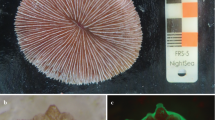Abstract.
Gonad morphology and colony composition support the existing supposition that the obligate coral-dwelling damselfish Dascyllus aruanus has a protogynous hermaphroditic sexual pattern. Adults had either an active ovary containing vitellogenic oocytes, an ovotestis, or a spermiated testis and were classified as adult female, hermaphrodite, or adult male, respectively. Among individuals having male function, the testis (or testis portion of the ovotestis) takes the form of an unrestricted spermatogonial lobular testis. Among hermaphrodites having an ovotestis, a small proportion of individuals had a gonad in which both the ovarian and testicular portions were inactive (inactive hermaphrodites), whereas the majority had a predominantly testicular ovotestis that contained spermatozoa (male-active hermaphrodites). The size range of individuals within gonadal classes indicates that all D. aruanus first develop an ovariform gonad. Some individuals then undergo ovarian maturation to become adult females while others develop testicular tissue to form an ovotestis and become male-active hermaphrodites. Subsequently, progressive loss of ovarian tissue results in the development of a secondary testis from an ovotestis with the retention of a residual, afunctional lumen among adult males. The wide size range of individuals having an ovotestis suggests that some hermaphrodites function as adult females before developing testicular tissue while other individuals do not pass through an adult female stage. If this is the case, D. aruanus exhibits a diandric protogynous hermaphroditic sexual pattern. The apparent prolonged retention of an ovotestis with both healthy oocytes and an ovarian-type lumen in a spermiated ovotestis, as well as a functional sex ratio of 1:1 for adult females:adult males plus male-active hermaphrodites also raises the possibility that D. aruanus may be capable of bidirectional sex change during the hermaphroditic stage. Such a capability would be highly adaptive for a species having limited mobility and unpredictable recruitment of new colony members resulting in unpredictable mating opportunities.
Similar content being viewed by others
Author information
Authors and Affiliations
Additional information
Electronic Publication
Rights and permissions
About this article
Cite this article
Cole, .K. Gonad morphology, sexual development, and colony composition in the obligate coral-dwelling damselfish Dascyllus aruanus. Marine Biology 140, 151–163 (2002). https://doi.org/10.1007/s002270100681
Received:
Accepted:
Issue Date:
DOI: https://doi.org/10.1007/s002270100681




